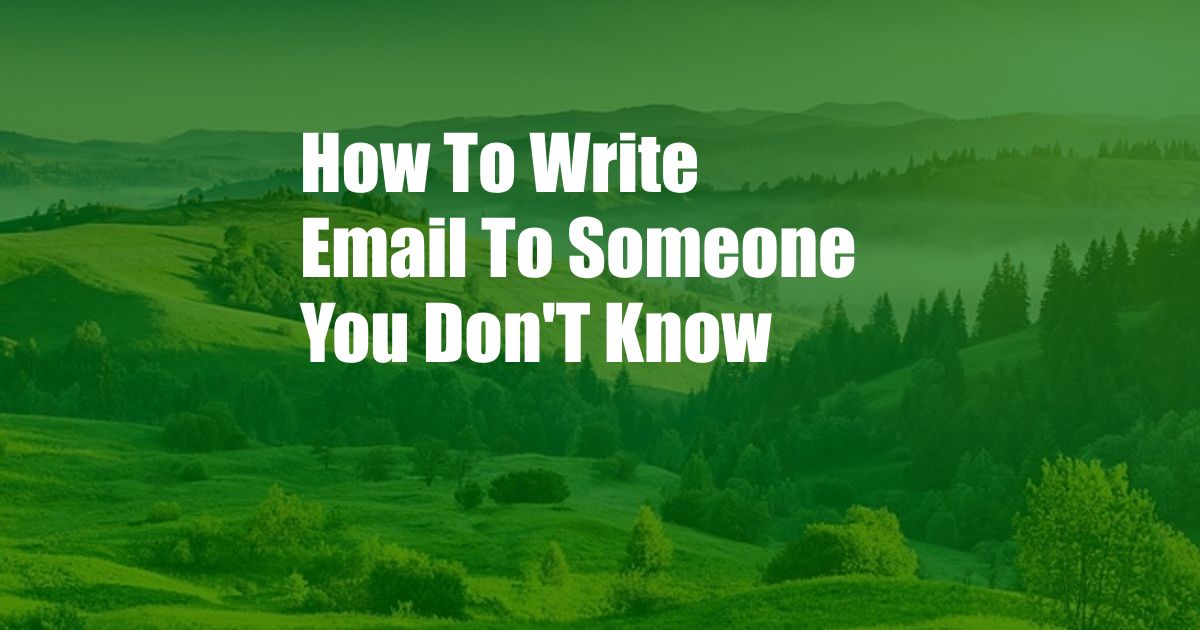
How to Craft Unforgettable Emails for Strangers: A Comprehensive Guide
Introduction
The digital landscape has transformed communication, making it easier than ever to connect with people we’ve never met. However, crafting an effective email to a stranger can be a daunting task. In this comprehensive guide, we’ll delve into the art of writing emails to those you don’t know, providing a step-by-step approach that will enhance your communication and leave a lasting impression.
The Importance of Personalization
When reaching out to someone you don’t know, personalization is key. Research the recipient’s industry, background, and interests to find common ground and tailor your message accordingly. This demonstrates that you’ve taken the time to understand their perspective and establishes a personal connection from the outset.
Crafting the Perfect Subject Line
The subject line is the gateway to your email, and it must be concise, compelling, and informative. Keep it within 50 characters to optimize visibility and curiosity. Use action verbs, highlight the value your email offers, and personalize it if possible.
Introduction: Establish Connection and Credibility
Begin your email with a friendly greeting, such as “Dear [Name],” or “Hello [Name].” Briefly introduce yourself, stating your name, company or affiliation, and the reason for your contact. Establish credibility by mentioning any relevant references or shared connections.
Body: Clearly State Your Purpose and Call-to-Action
Write a clear and concise body that outlines your purpose for contacting the recipient. Use specific details and examples to demonstrate the value you offer. State your call-to-action upfront, whether it’s requesting a meeting, asking for information, or proposing a collaboration.
Include a Personal Touch
Personalize your message by referring to the recipient’s recent work, accomplishments, or shared interests. Use a friendly and professional tone throughout, and avoid jargon or overly formal language.
Proofread Carefully
Before hitting send, carefully proofread your email for any errors in grammar, spelling, and formatting. A well-written and error-free email conveys professionalism and attention to detail.
Follow-Up
If you don’t receive a response within a reasonable time (typically 7-10 business days), consider sending a polite follow-up email. Keep it brief and restate your purpose. Avoid sending multiple follow-up emails in a short period, as it can come across as pushy.
Tips and Expert Advice
- Be respectful of the recipient’s time: Keep your email concise and to the point.
- Use a professional email address: Avoid using personal or whimsical email addresses.
- Personalize the email: Include the recipient’s name and show that you’ve done your research.
- Proofread carefully: Ensure your email is error-free before sending.
- Follow-up politely: If you don’t receive a response, consider sending a brief follow-up email.
FAQ
- How formal should my email be? The formality of your email should depend on the recipient and the context. For professional contacts, a formal tone is appropriate.
- What if I don’t have a shared connection? Mention how you found out about the recipient, such as through their company website or LinkedIn profile.
- How long should my email be? Keep your email to around 150-250 words to maintain clarity and engagement.
- What should I do if I don’t get a response? Follow up politely after 7-10 business days. If you still don’t receive a response, consider reaching out through other channels, such as LinkedIn.
Conclusion
Crafting an effective email to a stranger requires a balance of personalization, clarity, and professionalism. By following the guidelines outlined in this comprehensive guide, you can connect with individuals you don’t know, build lasting relationships, and achieve your communication goals.
Call to Action
Do you find the topic of communicating with strangers through email intriguing? Let us know in the comments below and share your experiences or any additional tips you may have. Your insights will help us continue to improve and provide valuable resources for our readers.